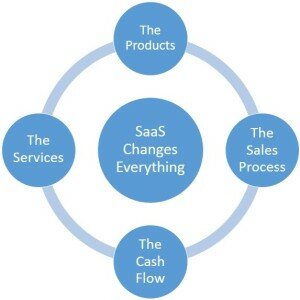
![]() Originally published on SandHill.com.
Originally published on SandHill.com.
SaaS fundamentally changes the products, services and relationships between SaaS vendors and their customers. Likewise, SaaS changes the role and value added by the SaaS channel partner. Channel partners will need to work differently and more strategically than in the past. And SaaS vendors and their channel partners must now work together to create a win-win environment.
The percent of software sold through the channel is much smaller with SaaS than traditional on-premises software. According to Software University, 35-45 percent of revenue comes from the channel, as contrasted with 60-70 percent of on-premises software. Only 23 percent of B2B SaaS vendors have SaaS channel programs. By contrast, 80 percent of on-premises software vendors have channel programs.
The primary reasons for the current lower use of channels by SaaS vendors include:
- There is no need for a channel partner for basic fulfillment, installation and upgrades— functions often performed by VARs.
- Basic configurations are done by the customer of a SaaS vendor rather than requiring a channel partner.
- Most SaaS companies are young, and they don’t usually initiate channel programs until their direct sales approaches are fully developed. They just “haven’t gotten around to” building a channel program.
- Most new SaaS companies have fewer international sales where the use of channel partners is more prevalent.
“What we see is VARs becoming more strategic advisors rather than implementers.” Hernan Marino, SAP SVP of Marketing for Ecosystem & Channels
Channels are a valuable and underutilized component of the SaaS ecosystem. SaaS vendors can use VARs and System Integrators to continue their torrid growth reaching new customers and providing services beyond their capabilities.
SaaS VARs and System Integrators have opportunities to expand into new clients with new SaaS offerings and new services developed around these SaaS offerings. SaaS provides an opening to prospects previously content staying with their status quo on-premises systems.
SaaS Changes the Software World
SaaS impacts everyone creating, selling or using software and changes the expectations of software consumers. It simplifies, commoditizes, democratizes and accelerates the use of software. SaaS commoditizes basic IT functions that were once expensive and makes them accessible at a lower cost.
“Cloud applications are designed to be simpler, so they require less professional services. It democratizes advanced capabilities, making them available to SMBs and business units.” Jeff Kaplan, THINKstrategies Managing Director
For example, website analytics used to be expensive, have been commoditized and are now free. Functions such as advanced predictive analytics used to be accessible only to the largest communities. SaaS companies such as Predixion Software have democratized these capabilities, making them available to firms of all sizes. In virtually all cases, SaaS simplifies the implementation and reduces the implementation time and amount of training needed.
By making advanced capabilities available at a lower cost, the SaaS market greatly expands. There are a lot more moving pieces in today’s world than in the past, which provides an opportunity for channels. The total IT expenditures with SaaS are generally higher since while equivalent capabilities may be less costly than for on-premises software, more advanced capabilities are provided as part of the implementation increasing the overall IT spend. New capabilities such as mobile, advanced analytics and business intelligence, and collaborative capabilities provide additional revenue opportunities for the channel partner.
SaaS now dominates the CRM market. Medical software applications swung rapidly from being nearly exclusively on-premises to dominantly SaaS. Markets once believed “safe” for on-premises solutions are shifting to SaaS in new deployments. SaaS had the greatest early penetration in SMBs but now is rapidly moving into larger organizations, once a bastion of on-premises software.
The base-level functions needed by an organization in areas such as ERP and CRM consume a much lower portion of the budget while shifting resources to new capabilities in social, collaboration, mobile, data visualization and Big Data analytics. Channel partners experience larger opportunities in enabling customers to use advanced capabilities.
The key to a SaaS channel partner’s success is to become the trusted resource to bring new SaaS capabilities to clients while helping transform customers to use them most effectively.
How SaaS Changes the Software World
Customers have heightened expectations of SaaS offerings, which vendors and channel partners must deliver.
- Lower cost than licensed software
- Shorter implementation time
- Lower cost for professional services
- Easier experimentation
- Lower application support costs
- Easy access to tech solutions previously out of reach
Hernan Marino observes, “The trend is the solution will offer much broader functionality. That presents a great opportunity for the vendor and the channel partner.”
New SaaS applications are mobile enabled, collaborative and use sophisticated analytics to offer more value. Customers now must adapt to much greater compliance, security and privacy requirements not likely met by their existing software. Applications are less likely to be “standalone” but require integration with a larger set of applications and data sources to provide the greatest value.
SaaS changes the role of the channel
“With cloud solutions, partners become strategic advisors, project coaches and field experts, helping clients gain rapid success.” Lori Seal, Blytheco (VAR) COO
SaaS requires channel partners to change the work they perform.
Low-value functions, order taking, fulfillment, installations and upgrades are gone. High-value roles, a strategic advisor, a business-transformation enabler and an integrator of many sophisticated components are the new channel focus. These differences change the channel role in sales, implementation and professional services.
The days of standalone applications are gone. A primary role of the channel is to provide a broader set of capabilities and make them work together. This forces the change in the DNA of many VARS and their staff.
SaaS Changes Sales
“Every prospect wants to explore SaaS – without SaaS solution, we wouldn’t get at a seat at the table.” Bob Gaby, Arxis Technology (VAR) Partner



